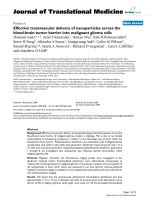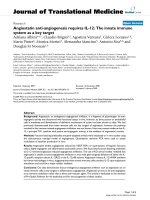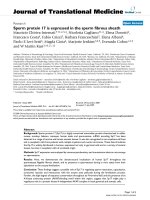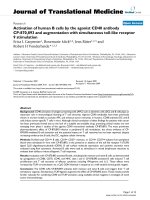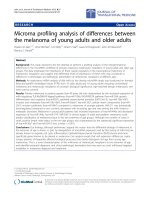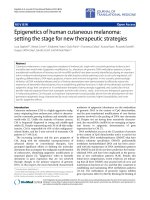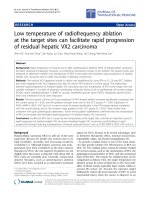báo cáo hóa học:" Bilateral hip arthroplasty: is 1-week staging the optimum strategy?" potx
Bạn đang xem bản rút gọn của tài liệu. Xem và tải ngay bản đầy đủ của tài liệu tại đây (241.13 KB, 6 trang )
RESEA R C H ART I C L E Open Access
Bilateral hip arthroplasty: is 1-week staging the
optimum strategy?
Henry D Atkinson
1,2*
, Christopher A Bailey
2
, Charles A Willis-Owen
2
, Roger D Oakeshott
2
Abstract
Seventy-nine patients underwent bilateral hip arthroplasty staged either at 1 week (Group 1) or after greater inter-
vals (as suggested by the patients, mean 44 weeks, range 16-88 weeks) (Group 2), over a five year period at one
Institution. Sixty-eight patients (29 bilateral hip resurfacings and 39 total hip replacements) completed question-
naires regarding their post -operative recovery, complications and overall satisfaction with the staging of their
surgery.
There was no significant age or ASA grade difference between the patient groups. Complication rates in the two
groups were similar and overall satisfaction rates were 84% in Group 1 (n = 32) and 89% in Group 2 (n = 36).
Cumulative hospital lengths of stay were significantly longer in Group 1 patients (11.9 days vs 9.1 days)(p < 0.01);
this was true for both hip resurfacing and total hip arthroplasty patients, however resurfacing patients stays were
significantly shorter in both groups (p < 0.01). Postoperative pain resolved earlier in Group 1 patients at a mean of
20.9 weeks compared with a cumulative 28.9 weeks (15.8 and 13.1 weeks) for Group 2 patients (p = 0.03).
The mean time to return to part-time work was 16.4 weeks for Group 1, and a cumulative 17.2 weeks (8.8 and 8.4
weeks) for Group 2. The time to return to full-time work was significantly shorter for Group 1 patients (21.0 weeks,
compared with a cumulati ve 29.7 weeks for Group 2)(p < 0.05). The time to return to both full and part-time work
was significantly shorter in total hip replacement patients with 1-week staging compared with delayed staging
(22.0 vs 35.8 weeks (p = 0.02), and 13.8 vs 19.3 weeks (p = 0.03) respectively).
Hip resurfacing patients in Group 2 had significantly shorter durations of postoperative pain and wer e able to
return to part-time and full time work sooner than total hip arthroplasty patients. There was a general trend
towards a faster recovery and resumption of normal activities following the second operation in Group 2 patients,
compared with the first operation.
Bilateral hip arthroplasty staged at a 1-week interval resulted in an earlier resolution of hip pain, and an earlier
return to full-time work (par ticularly following total hip replacement surgery), with high levels of patient satisfaction
and no increased risk in complications; however the hospital length of stay was significantly longer. The decision
for the timing of staged bilateral surgery should be made in conjunction with the patient, m aking adjustments to
accommodate their occupational needs and functional demands.
Introduction
The optimum timing for bilateral hip arthroplasty is
still under debate. Single-episode sequential bilateral
hip arthroplasty though potentially financially advanta-
geous and with shorter rehabilitation periods than
staged arthroplasty [1-6], has been associated with a sig-
nificantly increased risk of pulmonary complications,
post-operative anaemia and heterotopic ossification
[6-12].
Sequential bilateral total hip replacements during the
same hospitalisation period have been advoca ted to
avoid these potential complications whilst maintaining
the functional benefits of near simultaneous surgery;
and good clinical results and implant survivorship has
been previously reported for these patients [6].
This study compared the post-operative recovery,
complications and overall satisfaction rates of patients
undergoing one-week staged bilateral hip arthroplasty
surgery during the same hospitalisation period with
* Correspondence:
1
Department of Trauma and Orthopaedics and North London Sports
Orthopaedics, North Middlesex University Hospital, Sterling Way, London
N18 1QX, UK
Full list of author information is available at the end of the article
Atkinson et al. Journal of Orthopaedic Surgery and Research 2010, 5:84
/>© 2010 Atkinson et al; licensee BioMed Central Ltd. This is an Open Access article distributed under the terms of the Creative
Commons Attribution License ( which permits unrestricted use, distribution, and
reproduction in any medium, provided the original work is properly cited.
those undergoing surgery staged at intervals as sug-
gested by the patient.
Patients and Methods
Patients with bilateral hip osteoarthrit is were treated
with bilateral hip resurfacing (HR) or total hip replace-
ment (THR) surgery. HRs were de facto offered to all
patients unless contraindicated (by an age great er than
75 years, abnormal femoral head and neck morph olog y,
femoral neck osteopenia as confirmed with bone
mineral densitometry, or a patient preference for a
THR).
Hip resurfacings were performed by the senior author
using the Articular Surface Replacement (ASR) (Depuy
Ort hopaedics, Warsaw, Indian a) uncemented acetabular
and cemented femoral components. All procedures were
performed under general anaesthesia using a posterior
approach and the femoral compone nt was positioned
using computer navig ation (ASR Ci, Depuy Orthopae-
dics, Warsaw, Indiana/Brainlab, Feldkirchen, Germany).
Total hip replacements were performed by the senior
author under general anaesthesia using an anterolateral
approach. The pro cedure was performed using an ASR
uncemented acetabular componen t, uncemented Sum-
mit femoral stem and ASR XL metal femoral head
(Depuy Orthopaedics, Warsaw, Indiana).
Drains were placed in all patients for forty-eight hours
post-operatively and intravenous antibiotics were admi-
nistered until drains were removed. Wound closure was
performed using a non-absorbable subcuticular suture
which was removed at two weeks. Patients were mobi-
lised on the first post-operative day and low molecular
weight heparin thromboprophylaxis was administered
until discharge from hospital. After discharge, aspirin
150mg daily was prescribed for six weeks.
All patients were seen pre-operatively by a consultant
physician to assess their fit ness for an aesthesia. Patient
ASA (American College of Anaesthesiologists) grades
were recorded. Patients without medical contraindica-
tions were offered one-week staged bilateral procedures
during the same hospital admission (Group 1). Tho se
patients who declined one-week staging or who had
medical contraindications were allowed to choose when
they wished to undergo the contralateral procedure
(Group 2). Patients were not randomised to a staging
regime as it was apparent that the same schedule might
not suit all the patients and that the post-operative
requirements might differ betwee n patients such as
those in self employment and those who were retired.
All patients were sent a questionnaire evaluating the
time taken for their post-operative recovery, return to
daily activities (leisure activities, sport, work), surgical
complications and overall satisfaction with the timing of
their surgery. Patient case-notes were also reviewed.
Statistical analyses were performed using Microsoft
Excel statistical soft ware. Parametric data were analy sed
using an unpaired two-tailed T-test. Power analysis
(alpha 5%, beta 20%) indicated a minimum sample size
of twenty four patients in each group to detec t a differ-
ence in the average values for time to resolution of pain.
Results
Seventy-nine patients underwent bilateral hip arthro-
plasty between August 2003 and August 2008. Sixty-
eight patients returned completed questionnaires; of
those who did not retur n questionnaires six had 1-week
staged operations. Of those patients included in the ana-
lyses,fortyweremaleandtwentyeightfemalewitha
mean age of 58.2 years (range 36-80 years). Twenty-nine
underwent b ilateral HR and thirty-nine bilateral THR
surgery. There were thirty-two patients in Group 1 and
thirty-six patients in Group 2 (Table 1); 8 patients had
been allocated to Group 2 for medical reasons, including
three Jehovah’s witnesses; the remaining patients had
chosen to delay the staging of their surgery for personal
reasons. Eight of the thirty-two Group 1 patients were
retired. Most were in full-time employment working in
physically demanding occupations; including three farm-
ers, two policemen, two carpenters, two labourers, a
sports coach, an electrician, a wel der, a timber packer, a
fireman, and a truck driver; other professions included
two teachers, two company directors, a radiologist, a
nurse, an ultrasonographer, a journalist, and a salesman.
Seventeen of the thirty-six patients in Group 2 were
retired. Patients in this group included three farmers,
threeofficeworkers,threesales representatives, two
housewives, a service manager, a grazier, a secretary, a
civil engineer, a labourer, a teacher, an exploration geol-
ogist, and an architect.
There were no significant differences between the ages
(p = 0.59) or ASA grades (p = 0.09) between the groups,
though there was a trend towards a higher ASA grade
in Group 2 patients (Table 1). Group 1 had a larger pro-
portion of men, and Group 2 a larger proportion of
retirees. Patients undergoing HR were significantly
younger than those undergoing THR (p < 0.01) in both
groups, reflecting either a greater number of contraindi-
cations to hip resurfacing or a preference for THR
amongst our older patients. The mean interval between
procedures in Group 2 was 44 weeks (range 16-88
weeks). Mean follow-up from the date of initial surgery
was 34 months (range 12 to 60 months).
Cumulative lengths of hospital stay were significantly
longer in Group 1 patients (11.9 days compared with
9.1 days for Group 2 patients)(p < 0.01) (Table 2); this
was true for HR and THR patients. HR patients’ hospital
stays were significantly shorter than THR patients in
both groups (p < 0.01) (Table 2). Group 1 HRs stayed
Atkinson et al. Journal of Orthopaedic Surgery and Research 2010, 5:84
/>Page 2 of 6
for a mean of 11.1 days, while Group 2 HRs stayed a
cumulative7.3days(3.6and3.7days).Group1THRs
stayed for a mean of 12.6 days, while Group 2 THRs
stayed a cumulative 10.4 days (5.2 and 5.2 days).
The mean time to complete resolution of hip pain was
significantly shorter in Group 1 patients (20.9 co mpared
with a cumulative 28.9 weeks (15.8 and 13.1 weeks) for
Group 2 patients (p = 0.03)(Table 2). Further analysis
determined that this difference was due to a significantly
shorterdurationofpaininGroup1HRpatients
compared with Group 2 HR patients (26.0 versus 16.9
weeks)(p = 0.04); while there was no significant differ-
ence in pain duration for THR patients between the
groups (p = 0.22). Group 2 HR patients also had a sig-
nificantly shorter cumulative duration of pain than did
Group 2 THR patients (26.0 versus 31.0 weeks)(p =
0.02).
The mean time for returning to part-time work was
14.0 weeks for Group 1, significantly shorter than a
cumulative 17.2 weeks (8.8 and 8.4 weeks) for Group 2
Table 1 Patient Demographics
Number of Patients Mean Age (Years) Mean ASA grade Male: Female
Group 1 Hip Resurfacings 14 51.7 10:4
Total Hip Replacements 18 61.9 11:7
All Group 1 32 57.4 1.91 21:11
Group 2 Hip Resurfacings 15 52.1 6:9
Total Hip Replacements 21 63.7 13:8
All Group 2 36 58.9 2.11 19:17
All Patients 68 58.2 2.01 40:28
Table 2 Results
Cumulative
hospital length of
stay (days)
Cumulative time
until pain-free
(weeks)
Time to
independent
living (weeks)
Return to
leisure
activities
(weeks)
Return to
sport
(weeks)
Return to
work-Part time
(weeks)
Return to Work
- Full time
(weeks)
All Hip
Arthroplasty
Group 1 11.9 20.9 11.7 13.4 24.5 14.0 21.0
Group 2 9.1; (4.5, 4.6) 28.9; (15.8,13.1) 17.4; (9.3, 8.1) 22.2; (12.6, 9.6) 32.0; (17.1,
14.9)
17.2; (8.8, 8.4) 29.7; (15.4, 14.3)
p-value p < 0.01; (p = 0.81) p = 0.03;
(p < 0.01)
p = 0.02;
(p = 0.25)
p < 0.01;
(p < 0.05)
p = 0.21;
(p = 0.50)
p = 0.04;
(p = 0.72)
p < 0.05;
(p = 0.65)
Hip Resurfacing
Group 1 11.1 16.9 11.1 15.7 24.2 14.1 20.2
Group 2 7.3; (3.6, 3.7) 26.0; (14.5, 11.5) 15.6; (8.1, 7.5) 22.4; (12.1, 10.3) 34.0; (18.3,
15.7)
15.1; (7.5, 7.5) 22.9; (12.2, 10.7)
p-value P < 0.01; (p = 0.59) p = 0.04;
(p = 0.04)
p = 0.19;
(p = 0.47)
p = 0.16;
(p = 0.43)
p = 0.33;
(p = 0.67)
p = 0.60;
(p = 1.0)
p = 0.66;
(p = 0.65)
Total Hip
Replacement
Group 1 12.6 24.1 12.1 11.5 24.8 13.8 22.0
Group 2 10.4; (5.2, 5.2) 31.0; (16.7, 14.3) 18.7; (10.2, 8.5) 22.0; (12.9, 9.1) 30.8; (16.3,
14.4)
19.3; (10.0, 9.3) 35.8; (18.2, 17.6)
p-value p < 0.01; (p = 1.0) p = 0.22;
(p = 0.03)
p = 0.06;
(p = 0.34)
p < 0.01;
(p = 0.06)
p = 0.44;
(p = 0.62)
p = 0.03;
(p = 0.67)
p = 0.02;
(p = 0.81)
Comparing HR
and THR in
Group 1
11.9, 12.6 p < 0.01 16.9, 24.1 p = 0.34 11.1, 12.1
p = 0.82
15.7, 11.5
p = 0.25
24.2, 24.8
p = 0.92
18.6, 13.8
p = 0.30
20.2, 22.0
p = 0.76
Comparing HR
and THR in
Group 2
7.3, 10.4 p < 0.01 26.0, 31.0
p = 0.02
15.6, 18.7
p = 0.23
22.4, 22.0
p = 0.93
34.0, 30.8
p = 0.73
15.1, 19.3
p < 0.05
22.9, 35.8
p = 0.03
Key: HR - Hip Resurfacing, THR - Total Hip Replacement.
P-values: The first figure compares Groups 1 and 2, the second figure (in parentheses) compares differences between consecutive operations in Group 2 patients.
Atkinson et al. Journal of Orthopaedic Surgery and Research 2010, 5:84
/>Page 3 of 6
patients (p = 0.04). The mean time for returning to full-
time work was significantly shorter for Group 1 patients
(21.0 weeks compared with a cumulat ive 29.7 weeks for
Group 2)(p < 0.05). A further analysis showed that these
differences were due to a significantly shorter total time
off work in Group 1 THR patients compared with
Group 2 THR patients (22.0 versus 35.8 weeks)(p =
0.02). Group 1 THR patients were also able to return to
part-time work significantly earlier than Group 2 THR
patients (13.8 versus 19.3 weeks)(p = 0.03).Differences
between Group 1 and 2 HR patients were not signifi-
cant. Group 2 HR patients were able to return to part-
time and full-time work, and leisure activities signifi-
cantly earlier than Group 2 THR patients. Group 1
patients were able to return to independent living signif-
icantly sooner than Group 2 patients (p = 0.02), even
when corrected for patient age (p < 0.05). There were
no significant differences in the time taken to return to
sporting activities between the groups. There was a gen-
eral trend for Group 2 patients to have a faster recovery
and an earlier resumption of normal activities follo wing
their second operation, compared with their first
operation.
All patients were asked whether they would have sur-
gery staged in the same way again. Twenty-seven (84%)
Group 1 patients stated they would, one was not sure
and four stated they would not. These four patients
would have rather had their surgery staged more than
six months apart; 1 of these patients was retired and 2
had heavy labouring jobs. Twenty-nine Group 2 patients
(81%) stated they would have surgery staged in the same
way again and seven would not. Of these seven patients,
six patients would have preferred the interval between
operations to be shorter (4 retirees) and one patient
(teacher) would have preferred a longer interval between
procedures.
Twenty-seven of the Group 1 patients (84%) were
either satisfied or very satisfied with the staging of their
surgery. Three patients had been neither satisfied nor
dissatisfied, and two patients were very dissatisfied with
the staging of their surgery. Thirty-two of the Group 2
patients (89%) were ei ther satisfied or very satisfied, two
were neither satisfied nor dissatisfied, and two patients
had been dissatisfied.
Patient-reported post-operative complication data is
showninTable3.SixpatientsinGroup1andsevenin
Group 2 described hip pain as a complication. One
Group 1 patient who had undergone bilateral staged
total hip replacements had persistent pain in one hip
and subsequently underwent a revision procedure twelve
months postoperatively at a different hospital. There
were no significant differences in wound or urinary tract
infections, leg length discrepan cy, abductor detachment,
deep vein thrombosis or pulmonary embolus rates
between the two groups. Four Group 1 patients attribu-
ted their complications to the timings of their surgery.
One patient had required oral antibiotics for a superfi-
cial wound infection following hip resurfacing, which
subsequently resolved. One female patient developed a
urinary tract infection a fter catheterisation which had
been required until she was fully ambulant.
Discussion
The optimum timing for bilateral hip arthroplasty is still
under debate. Single-episode sequential bilateral hip
arthroplasty has been shown to have t he advantages of
lower costs of inpatient hospital stay and anaesthesia, a
shorter overall post-operative rehabilitation time, a
reduced length of time to completion of surgery and
improved hip mobility due to rel eases of t he contralat-
eral hip contractures [1-6]. However they have been
associated with a sig nificantly increased risk of pulmon-
ary complications, post-operative anaemia and heteroto-
pic ossification [6-12]. Simultaneous bilateral total knee
arthroplasty surgery has similarly been associated with
higher rates of serious cardiac and pulmonary complica-
tions when compared with staged bilateral and unilateral
total knee replacements [13].
Sequential bilateral total hip replacements during the
same hospitalisation period have been advoca ted to
avoid these potential complications whilst maintaining
the functional benefits of near simultaneous surgery;
and good clinical results and implant survivorship have
been previously reported in these patients [6]. One-week
staged bilateral total knee replacements have similarly
been shown to have lower complication rates, with
lower total operative blood losses than for single episode
(simultaneous/sequential) or longer-interval staged pro-
cedures [14].
Cumulatively, our study s howed that bilateral hip
arthroplasty staged at a 1-week interval resulted in an
earlier r esolution of hip pain, an earlier return to inde-
pendent living and leisure activities, and l ess cumulative
time off work than surgery staged at greater intervals;
this was particularly true of total hip replacement
patients. The study also found that hip resurfacing
patients had shorter hospital lengths of stay than total
hip replacement patients with both staging regimes. Hip
resurfacing patients also had a shorter duration of pain
and less time off work than total hip replacement
patients (in those patients having delayed bilateral hip
arthroplasty).
Our study found that cumulative l engths of hospital
stay were significantly longer in the 1-week staged
cohort (3.8 days longer for HR and 2.2 days longer for
THR patients), with resultant increased hospital costs.
This was primarily due to patients being kept in hospital
for a full 7 post-operative days following their first
Atkinson et al. Journal of Orthopaedic Surgery and Research 2010, 5:84
/>Page 4 of 6
surgery; thus potentially artificially prolonging their
length of stay. If one assumed that the length of stay
from the first surgery was the same as that of the sec-
ond surgery in Gro up 1 patient s (with patients b eing
sent home “ on leave” between procedures), this would
mean that the corrected mean cumulative lengths of
stay for HR patients would be 8.2 days (twice 4.1 days),
and 11.2 days (twice 5.6 days) for THR patients. The
corrected values of hospital length of stay stil l however
remain significantly longer than those of Group 2
patients (HR 8.14 days versus 7. 33 days (p = 0.04), THR
11.22 versu s 10.38 days (p = 0.02)). However it is likely
that these increased hospital co sts would be offset by
savings from patients only having to undergo a single
rehabilitation period; not to mention the potential cost
savings of patient s having a shorter overall period off-
work.
Thus a one week staging regime might appeal to those
patients wishing to have as little cumulative time from
full-time work as possible, and the shortest overall dis-
ruption to their ability t o live independently. While
retired patients or those i n sedentary occupations might
rather prefer procedures with delayed staging, which
might allow them to return (to work), leisure and sport-
ing activities sooner (while between procedures).This
rationale may explain why a higher proportion of men
and those in self-employment chose one week staging
on our series.
With very high levels of patient satisfaction reflected
with both types of staging regime and no significant dif-
ference in observed complication rates, the decision for
the timing of staged bilateral surgery should be made in
conjunction with the patient, making adjustments to
accommodate their occupational needs and functional
demands.
Though the inclusion of different forms of hip arthro-
plasty and the methods of patient selection may be criti-
cised, the numbers of hip resurfacings and total hip
arthroplasties and patients demographics were broadly
similar; and the rehabilitation schedules and complica-
tion rates were comparable. This study also benefitted
from being a single surgeon series thus reducing the
potential variability in surgic al practice seen in other
studies of bilateral hip staging surgery [15].
Consent
Written informed consent was obtained from all
patients for their data inclusion in this and other
research at our Institution. Copies of these consent
forms are available for review by the Editor-in-Chief of
this journal
Abbreviations
HR: hip resurfacing; THR: total hip replacement; ASA: American College of
Anaesthesiologists;
Author details
1
Department of Trauma and Orthopaedics and North London Sports
Orthopaedics, North Middlesex University Hospital, Sterling Way, London
N18 1QX, UK.
2
Sportsmed SA, 32 Payneham Road, Stepney 5069, Adelaide,
South Australia, Australia.
Authors’ contributions
All the patients underwent arthroplasty surgery by RO. HA, CB and CWO
wrote the manuscript. All authors have read and approved the final
manuscript.
Competing interests
The authors declare that they have no competing interests.
Received: 11 July 2010 Accepted: 6 November 2010
Published: 6 November 2010
References
1. Eggli S, Huckell CB, Ganz R: Bilateral total hip arthoplasty: one stage
versus two stage procedure. Clin Orthop 1996, 328:108-18.
2. Schäfer M, Elke R, Young JR, Gancs P, Kindler CH: Safety of one-stage
bilateral hip and knee arthroplasties under regional anaesthesia and
routine anaesthetic monitoring. J Bone Joint Surg [Br] 2005, 87-B:1134-40.
3. McBryde CW, Dehne K, Pearson AM, Treacy RBC, Pynsent PB: One-or two-
stage bilateral metal-on-metal hip resurfacing arthroplasty. J Bone Joint
Surg [Br] 2007, 89-B:1144-8.
Table 3 Complications
Hip
Pain
Superficial Wound
Infection
Urine
Infection
Leg Length
Discrepancy
Abductor
Detachment
Deep Vein
Thrombosis
Pulmonary
Embolus
All Hip
Arthroplasty
n=68
Group 1 6421200
Group 2 7413011
Hip Resurfacing n=29
Group 1 1300100
Group 2 3110010
Total Hip
Replacement
n=39
Group 1 5121100
Group 2 4303001
Atkinson et al. Journal of Orthopaedic Surgery and Research 2010, 5:84
/>Page 5 of 6
4. Macaulay W, Salvati EA, Sculco TP, Pellicci PM: Single-stage bilateral total
hip arthroplasty. J Am Acad Orthop Surg 2002, 10(3):217-221.
5. Reuben JD, Meyers SJ, Cox DD, Elliott M, Watson M, Shim SD: Cost
comparison between bilateral simultaneous, staged, and unilateral total
joint arthroplasty. J Arthroplasty 1998, 13(2):172-179.
6. Jewett BA, Collis DK: Sequential bilateral total hip replacement during
the same hospitalization. Clin Orthop 2005, 441:256-61.
7. Berend ME, Ritter MA, Harty LD, Davis KE, Keating EM, Meding JB,
Thong AE: Simultaneous bilateral versus unilateral total hip arthroplasty.
J Arthroplasty 2005, 20:421-6.
8. Salvati EA, Hughes P, Lachiewicz P: Bilateral total hip-replacement
arthroplasty in one stage. J Bone Joint Surg [Am] 1978, 60-A:640-4.
9. Parvizi J, Pour AE, Peak EL, Sharkey PF, Hozack WJ, Rothman RH: One-stage
bilateral total hip arthroplasty compared with unilateral total hip
arthroplasty: a prospective study. J Arthroplasty 2006, 21(Suppl 2):26-31.
10. Parvizi J, Tarity TD, Sheikh E, et al: Bilateral total hip arthroplasty: one-
stage versus two-stage procedures. Clin Orthop Relat Res 2006,
453:137-141.
11. Trojani C, Chaumet-Lagrange VA, Hovorka E, Carles M, Boileau P:
Simultaneous bilateral total hip arthroplasty: literature review and
preliminary results. Rev Chir Orthop Reparatrice Appar Mot 2006,
92(8):760-7.
12. Ritter MA, Vaughan RB: Ectopic ossification after total hip arthroplasty:
predisposing factors, frequency, and effect on results. J Bone Joint Surg
[Am] 1977, 59-A:345-51.
13. Restrepo C, Parvizi J, Dietrich T, Einhorn TA: Safety of simultaneous
bilateral total knee arthroplasty: a meta-analysis. J Bone Joint Surg [Am]
2007, 89-A:1220-6.
14. Forster MC, Bauze AJ, Bailie AG, Falworth MS, Oakeshott RD: A
retrospective comparative study of bilateral total knee replacement
staged at a one-week interval. J Bone Joint Surg [Br] 2006, 88-B:1006-10.
15. Saito S, Tokuhashi Y, Ishii T, Mori S, Hosaka K, Taniguchi S: One- versus
two-stage bilateral total hip arthroplasty. Orthopedics 2010, 33(8).
doi:10.1186/1749-799X-5-84
Cite this article as: Atkinson et al.: Bilateral hip arthroplasty: is 1-week
staging the optimum strategy? Journal of Orthopaedic Surgery and
Research 2010 5:84.
Submit your next manuscript to BioMed Central
and take full advantage of:
• Convenient online submission
• Thorough peer review
• No space constraints or color figure charges
• Immediate publication on acceptance
• Inclusion in PubMed, CAS, Scopus and Google Scholar
• Research which is freely available for redistribution
Submit your manuscript at
www.biomedcentral.com/submit
Atkinson et al. Journal of Orthopaedic Surgery and Research 2010, 5:84
/>Page 6 of 6
